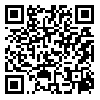BibTeX | RIS | EndNote | Medlars | ProCite | Reference Manager | RefWorks
Send citation to:
URL: http://tumj.tums.ac.ir/article-1-7085-en.html
2- Ph.D. Student of Reproductive Biology, Tehran University of Medical Science, Tehran, Iran.
3- Department of Obstetric and Gy-necology, Tehran University of Medical Science, Tehran, Iran.
Background: Receptivity of endometrium has a critical role in the establishment of pregnancy after embryo transfer in the treatment process of infertile couples. As the glycoprotein CA-125 is a product of human endometrium and is measurable in the peripheral circulation, it is investigated whether it might serve as an indicator of endometrial receptivity and predictor of pregnancy following Intracytoplasmic sperm injection (ICSI).
Methods: In an observational diagnostic study, over a twelve-month period (from August 2013 to July 2014), all couples with male-factor infertility who attended to infertility clinic of Moheb Yas Hospital, Tehran and were candidate of performing ICSI, were invited to participate in the study. Based on the inclusion criteria of study, 64 women were eligible to take part in the study. They were assessed for serum CA-125 levels on the day of human chorionic gonadotropin (HCG) administration and also on the day of oocyte retrieval. After ICSI, the possibility of pregnancy was assessed by measuring serum concentration of &beta-HCG on 14 days after embryo transfer and also by visualizing the gestational sac by trans-vaginal ultrasound examination on four to five weeks after transfer. The pregnancy rate was compared between those with normal and high CA-125 levels.
Results: Among the subjects, 15 patients (23.4%) had high CA-125 levels, and totally 19 patients (29.7%) experienced pregnancy. Among those with normal and high CA-125 levels, 16 patients (32.7%) and 3 subjects (20%) experienced pregnancy, respectively, that showed no statistically significant difference according to Chi-square test (P=0.348). Also, according to the Fisher’s exact test, there was no correlation between CA-125 levels and the rate of pregnancy on the basis of body mass index (BMI).
Conclusion: Totally, according to the obtained results in current study, it may be concluded that serum CA-125 levels has no prognostic value in prediction of the outcomes of ICSI among infertile couples with male-factor infertility.
| Rights and permissions | |
 |
This work is licensed under a Creative Commons Attribution-NonCommercial 4.0 International License. |





